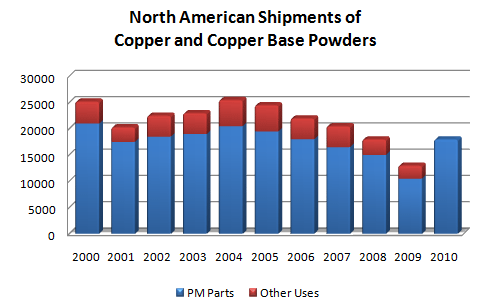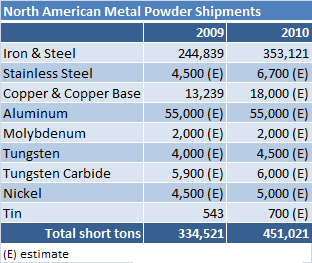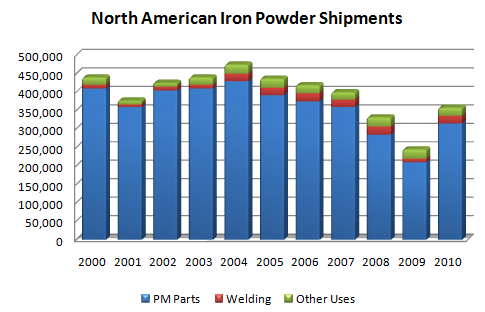North American powder metallurgy (PM) industry begins to show growth
“While the dramatic rebound can be largely pinned on the increase in light-vehicle sales, other end markets also gained,” stated Michael E. Lutheran. “PM’s design-engineering advantages, contributions to sustainability, and proven economies are stronger than ever.”
“The industry’s real turnaround actually began during the last quarter of 2009 when customer inventories were at their lowest point and the pipeline needed refilling,” continued Lutheran. “This situation signalled a firming of demand for metal powders and PM parts. A clear indicator of rising production levels was the hiring spurt seen at many PM parts fabricator plants.”
Total 2010 North American metal powder shipments increased about 35% to an estimated 451,021 short tons. Total iron and steel powder shipments in 2010 soared by 44.2% to 353,121 short tons.
The PM parts share represented 315,192 short tons, a 50% increase over 2009 levels. Lutheran pointed out that 2009 was a dismal year and the increase brought the industry to levels still below its peak year of 2004, when iron powder shipments hit almost 474,000 tons.
“Nevertheless, we are back on the growth track, regaining momentum in nearly every quarter,” he said.
Copper powder shipments in 2010 also advanced to an estimated 18,000 short tons, a 36% increase from 2009. Stainless steel powder shipments jumped as well, to an estimated 6,700 short tons, an increase of almost 50%.
North American metal injection moulding (MIM)-grade powder shipments increased close to 29% percent in 2010 to over one million lbs.
Shipments of PM tool steel, high-alloy materials, and tungsten also registered gains in 2010.
Internationally, PM industry production rose in Europe, Asia, and South America last year. China, South Korea, Brazil, Japan, and India enjoyed substantial increases.

North American Copper and Copper Base Powder Shipments (Short Tons) 2000 – 2010. Please note 2010 combined estimate (courtesy MPIF)
The 2011 Outlook
Based on the first quarter of 2011, PM industry executives remain optimistic about the business outlook, Lutheran reported. Iron powder shipments increased 9.1% in the first quarter, with the PM parts/friction materials sector up 10.1%. Stainless steel powder shipments remain robust and copper powder shipments are positive as well.
According to discussions with leading PM parts makers, business in the first half of 2011 looks very favourable. First-quarter sales reports show increases ranging from 10 to 35% with strong back orders. While many companies have rehired production workers who had been previously laid-off, they are still running with leaner workforces than before, Lutheran stated.
Automotive Scene
During April, demand remained firm in PM’s largest market. PM parts found in new engines and six-speed transmissions use substantial amounts of metal powder. For example, GM and Ford six-speed models contain from 28 to 34 lbs (12.7 – 15.5 kg) of PM parts. Overall, the average U.S. made vehicle in 2010 contained an estimated 41.6lbs (18.8 kg) of PM parts, with a slight gain to almost 42lbs (19 kg) forecast for 2011.
Technology Developments
The hot isostatic pressing (HIP) market is growing, supported by demand for large stainless steel and superalloy HIPed near-net shapes for energy and industrial applications. Markets for PM high-speed steel and tool-steel wrought mill forms such as bar, plate, and wire are expanding as well. Future trends include PM HIPed shapes replacing forgings and castings because of improved and consistent microstructures, isotropic properties, and improved inspection, and HIP units capable of operating at higher temperatures.
The Isostatic Pressing Association (IPA), representing both HIP and cold isostatic pressing (CIP), reported increases in net-shape parts and in the development of new alloys. According to IPA, PM accounts for an estimated 42% of HIP applications. In contrast, PM accounts for an estimated 57% of CIP applications. Other uses of HIP and CIP include ceramics and densification of castings and MIM parts. The most important HIP and CIP end markets are aerospace, defence, electronics, oil and gas, and medical.
The Metal Injection Molding Association (MIMA) forecasts increasing sales in 2011. The association characterises the growth of the MIM business today as having reached the evolutionary stage rather than the early hyper-growth of past years. The most important MIM markets are medical, firearms, electronics, dental, automotive, and telecommunications. There are approximately 40 MIM parts producers in North America accounting for an estimated $200 million in annual sales. Captive companies making parts for the orthodontic, medical, and firearms markets account for an estimated 30% of MIM production.
The MPIF Technical Board has been active in assessing threats and opportunities posed by competitive technologies as well as R&D priorities, and is investigating the potential of alternative- energy sources and lightweight materials as part of an upcoming technology assessment report. It is also working on revising the 10-year-old PM Industry Roadmap document.
Edited by: Paul Whittaker, Editor ipmd.net, [email protected]
News | Articles | Market reviews | Search directory | Subscribe to e-newsletter







